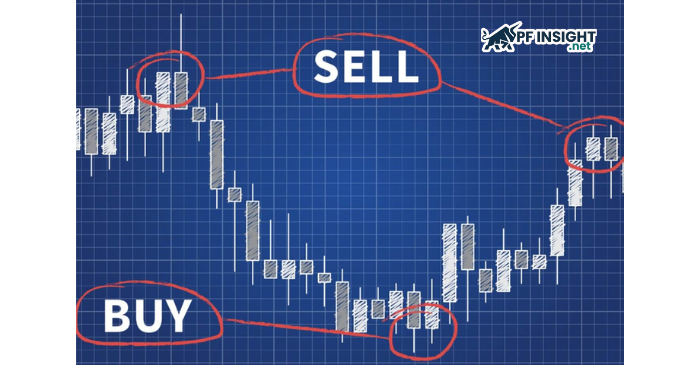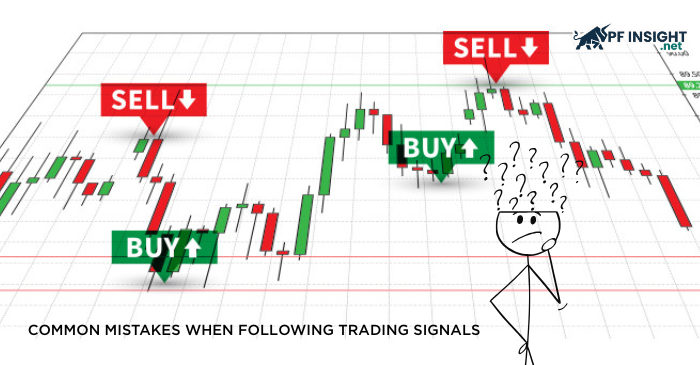Trading signals are powerful tools used by many traders to identify market opportunities faster and with greater accuracy. These signals are typically generated using algorithms, technical analysis models, or strategies developed by experienced traders. However, not all market signals are reliable. Many beginners often get drawn into so-called “magic signal groups” or misleading profit promises, which can lead to unnecessary losses. Therefore, knowing how to choose trustworthy trading signals is crucial not only to enhance your strategy but also to protect your account from avoidable risks.
In this guide, PF Insight will help you understand what trading signals are, why they matter, and how to choose the most reliable signal sources that align with your trading strategy.
- Best Indicators for Prop Firm challenge to boost your success
- Top 5 most common Reversal Candlestick Patterns explained for smart trading
- Boom and crash trading explained for beginners
What are trading signals?
In the financial markets, trading signals are alerts or recommendations that assist traders in deciding when to purchase, sell, or hold positions. These signals can be based on technical analysis, fundamental analysis, or a combination of both. Their main purpose is to provide clear, actionable insights that help traders make faster and more accurate decisions.
For instance, when two Moving Averages (MA) cross, suggesting a possible trend reversal, or when the RSI rises above 70, indicating an overbought situation, a market signal may emerge.
In general, there are two main types of trading signals:
- Manual trading signals: Generated by human analysts or experienced trading groups based on market interpretation and expertise.
- Automated trading signals: Produced by software or algorithms that detect patterns and opportunities in real time using live market data.
Each type has its own strengths and limitations, but the key point is this: not all signals are reliable. Traders should understand how signals are generated before using them as part of their strategy.
Example: A scalper might use a signal such as “EMA Cross Buy” to enter trades quickly on the M5 timeframe, while a swing trader could rely on “RSI Divergence” signals to identify major trend reversals and hold positions longer.
Why choosing reliable trading signals matters

A single incorrect signal might mean the difference between a profit and a loss in trading. The quality and transparency of market signals, whether produced by algorithms or by humans, are always the primary determinants of your trading outcomes.
If you rely on unverified trading signals such as those widely shared on social media or unregulated Telegram groups, you expose yourself to several risks:
- Entering trades against the market trend.
- Executing trades too late due to delayed signals.
- Falling into the “overtrading” trap caused by misleading or fake alerts.
On the other hand, choosing reliable and well-tested signal sources offers significant advantages:
- Reduced decision-making pressure during volatile market conditions.
- Improved trading discipline, as signals help you follow a structured system.
- Enhanced overall performance, especially when combining verified signals with your personal trading strategy.
Example: A swing trader may follow trusted breakout signals from providers with proven backtest histories instead of relying on random tips from social media.
How to choose reliable trading signals (step-by-step)
Selecting trustworthy trading signals involves more than just examining profit margins; it also involves assessing the signals’ performance, source, and suitability for your trading style.
The five steps listed below will assist you in identifying the signals that actually produce reliable and consistent outcomes:
Verify the signal provider
Start by checking the credibility of the provider. A reputable source should:
Have a transparent track record with publicly verified results.
Provide backtests or verified data from platforms such as MyFXBook or FX Blue.
Avoid unrealistic claims like “guaranteed profit” or “zero-loss strategy.”
Review actual performance
A good trading signal is not just about high win rates; it’s about consistency and risk control.
Key metrics to check:
- Win rate: at least 55–60% over a long period.
- Drawdown: ideally below 15%, showing proper risk management.
- Equity curve: should grow steadily, without sharp spikes or drops.
Assess trading style compatibility
Not every signal fits every trader. Choose one that aligns with your own strategy and timeframe:
- Scalpers: need high-frequency, fast-response signals.
- Swing traders: prefer signals on H4 or Daily charts, with clear trend direction.
- Position traders: look for long-term signals that include fundamental insights.
Check signal delay (latency)
One of the most crucial factors is signal timing.
If a signal is delayed by even a few minutes, you could enter at a completely different price level.
Choose systems that provide real-time alerts (via Telegram, app notifications, or email).
Avoid manually compiled signals if you trade short-term or intraday.
Test on a demo account before going live
No matter how reliable a signal appears, always test it in a demo account first. This helps you:
- Understand how the signal performs in real-time conditions.
- Control your emotions when following external signals.
- Measure consistency before risking actual funds.
In summary, the most successful traders always test first rather than rely first, and the best trading signals combine transparency, accuracy, and consistency.
Common mistakes when following trading signals

Your trading performance can still be derailed by improper use of trustworthy trading signals, even if you have selected them. The most frequent errors that traders, particularly novices, make when interpreting signals are listed below:
Blindly trusting signals without verification
Many traders assume that a “sure-win” signal is all they need.
They enter trades without analyzing the market context, which often leads to losses even when the signal itself was technically correct.
Tip: Always confirm signals with your own analysis, such as trendlines, volume, or price action, before taking a trade.
Using signals that don’t match your trading style
A day trader can’t effectively use signals designed for position trading; the timeframe, stop-loss levels, and profit targets are entirely different.
Tip: Make sure the signals you follow align with your speed, holding duration, and acceptable risk tolerance.
Ignoring risk management when following signals
Even high-quality signals come with the possibility of losses.
If you trade without a stop loss or open oversized positions, just one bad signal can wipe out your account.
Tip: Never risk more than 2% of your capital per trade, no matter how “certain” a signal looks.
Buying signals from unverified sources
Many providers advertise a “95% win rate” but offer no verifiable proof.
The result? Traders lose money on both the subscription and the trades themselves.
Tip: Only trust signal providers with transparent stats verified by MyFXBook, FX Blue, or other reputable tracking platforms.
Failing to track and evaluate signal performance over time
A common mistake is not recording trade results.
If you don’t review performance weekly or monthly, you won’t know when to stop or switch to a better source.
Tip: Keep a trading journal or Excel sheet recording signal time, trade result, and market conditions.
Conclusion
Choosing trustworthy trading signals not only helps you locate better trading opportunities but also enhances your discipline and risk control throughout your financial journey. It’s crucial to keep in mind that no signal is flawless; the true distinction is in the way you assess, confirm, and utilize those signals in your own plan.
Before spending real money, start by examining actual performance statistics, evaluating signals on a demo account, and determining the signal provider’s authenticity. You won’t merely trade based on signals when you learn to integrate reliable market signals with your own analysis; instead, you’ll trade with confidence, control, and strategy.







